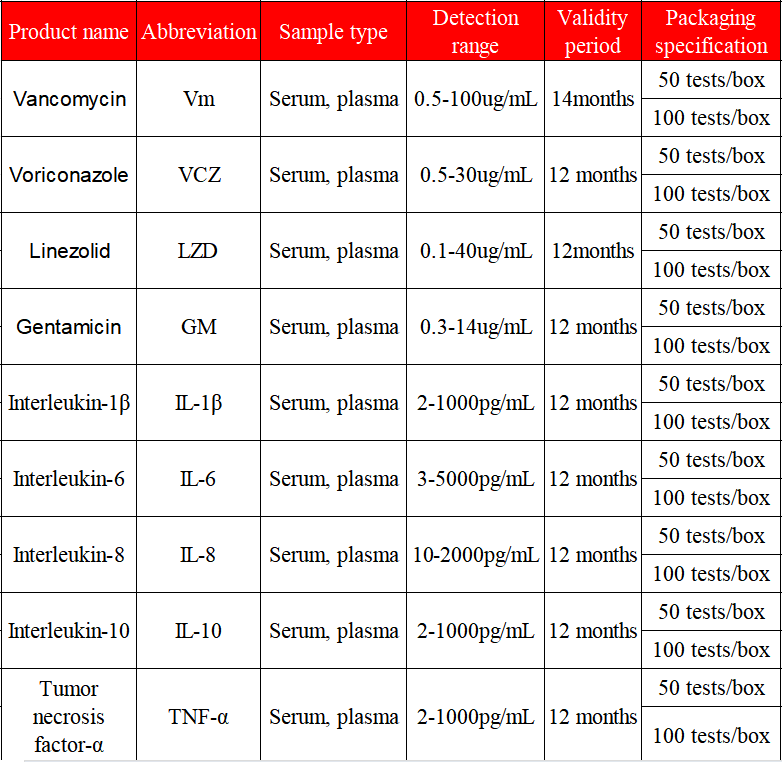When it comes to the three major infection markers, what everyone must think of is PCT+IL-6+CRP. As an infection marker that entered the market earlier, PCT has gradually become well-known to everyone. In recent years, with the high incidence of infectious diseases, the clinical application of IL-6 has attracted more and more attention. The National Health and Family Planning Commission (National Health Office Medical Letter [2015] No. 252) "Quality Control Indicators for Hospital Infection Management" and "Quality Control Indicators for Critical Care Medicine Professionals" stipulate that pathogenic
specimens should be tested before antimicrobial drug treatment. Microbial culture, procalcitonin and interleukin-6 are stipulated as pathogenic test specimens, but the commonly used CRP is not included. IL-6 is a multifunctional cytokine that can serve as both a pro-inflammatory cytokine and an anti-inflammatory myokine and is an important member of the cytokine network. When infection and inflammation occur, IL-6 is produced first after the inflammatory reaction occurs and remains at a high level for a long time. IL-6 is a sensitive indicator for the early diagnosis of acute infection. It can especially be used as a differential diagnosis indicator for patients with early infection. It has important reference significance for formulating treatment plans and improving prognosis, and assists in accurate diagnosis of diseases.
The main clinical significance of IL-6 is as follows:
When infection/inflammation occurs, IL-6 is first produced and the level rises rapidly, reaching a peak at 2 hours, and its elevated level is consistent with the severity of the infection.
IL-6 is a sensitive indicator for the early diagnosis of acute infection, especially as a differential diagnosis indicator for early neonatal sepsis, and has important reference significance for formulating treatment plans and improving prognosis for children.
The increase in IL-6 level is positively correlated with the severity of the disease, and the increase reflects the severity of the disease.
4、The sensitivity of IL-6 in distinguishing infection from non-infection is higher than that of PCT and CRP, and it can also be used to evaluate the severity of infection and assess prognosis.
Precision diagnosis and treatment is the future direction of medical development in China, and individualized medication can improve the safety and effectiveness of medication and is one of the important manifestations of precision diagnosis and treatment. Currently, therapeutic drug monitoring (TDM) has become the core support point for clinical personalized dosing regimens.
At present, the most widely used antibacterial drugs in TDM are glycopeptides and triazole antibiotics. Glycopeptide antibiotics are represented by vancomycin. Vancomycin is significantly toxic to the kidneys. TDM is required when used in combination with ototoxic drugs such as aminoglycosides, when used in patients with reduced renal function, when used for a long time, and when used in patients with special metabolic properties of vancomycin. Antifungal drugs TDM are mainly triazole drugs, including voriconazole, itraconazole, etc. This type of drug has a narrow therapeutic window and large individual differences, and studies have shown that blood drug concentration is related to both efficacy and toxicity. In addition, triazole drugs exhibit nonlinear pharmacokinetic processes in vivo. When patients use this drug for a long time or in large doses, drug accumulation may occur, causing toxic side effects. Possible reactions can be monitored through TDM, allowing timely clinical countermeasures to be taken. The main representative of oxazolidinone antibacterial drugs TDM is linezolid. Linezolid has good antibacterial effects against most Gram-positive bacteria, including multi-drug-resistant Enterococcus, Staphylococcus and Streptococcus pneumoniae., is the last line of defense against glycopeptide multidrug resistance in Gram-positive bacterial infections.
In clinical treatment, for bacterial infections with higher MIC (minimum inhibitory concentration), higher drug concentrations are needed to achieve the target PK/PD (pharmacokinetics/pharmacodynamics), but too high a concentration can cause adverse reactions, such as thrombocytopenia, etc. For patients with a longer course of treatment, linezolid exhibits an accumulation effect, and the drug concentration gradually increases during follow-up. Therefore, it is recommended that regular TDM be performed for patients with a long course of treatment to prevent the occurrence of adverse reactions.
At present, the importance of antibiotic TDM such as vancomycin, voriconazole, and linezolid in clinical precision treatment has become a consensus, and the demand for clinical antibiotic TDM is increasing.
National policy focuses on supporting development projects
Recently, in order to actively respond to the challenges posed by microbial resistance, implement the Biosafety Law of the People's Republic of China, and better protect people's health, 13 departments including the National Health Commission jointly formulated a national action plan to curb microbial resistance (2022- 2025) " Key Points: Encourage the development of rapid diagnostic equipment and reagents for drug-resistant bacterial infections, and support the development of cheap and easy-to-promote drug concentration monitoring technology.
Diagreat Biotec uses chemiluminescence technology to innovatively integrate routine infection detection projects with antibiotic drug concentration monitoring projects, forming an exclusive solution from infection diagnosis to precise treatment. Diagreat Biotech’s personalized anti-infection diagnosis and treatment plan: infection/inflammation diagnosis (IL-6, IL-1β, IL-2 receptor, IL-8, IL-10, TNF-α) + anti-infection precision treatment (vancomycin, voriconazole, linezolid, gentamicin, teicoplanin, meropenem), the two swords combine to help rational and precise use of antibiotics and reduce antibiotic abuse. At the same time, Diagreat Biotecg chemiluminescence Solution realizes fully automatic high-speed detection of samples in and results out, with the advantages of unattended, full-process quality control, and stable and reliable results. Effectively provide clinical individualized precise diagnosis and treatment and complete professional testing services to protect patients' lives and health.
